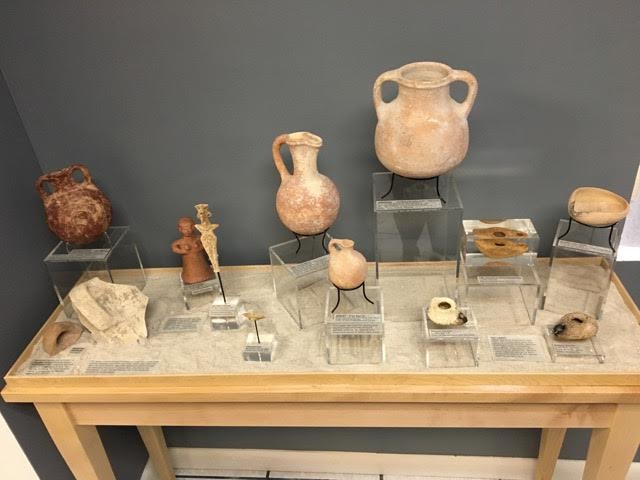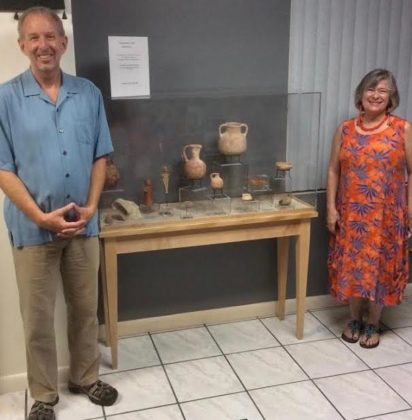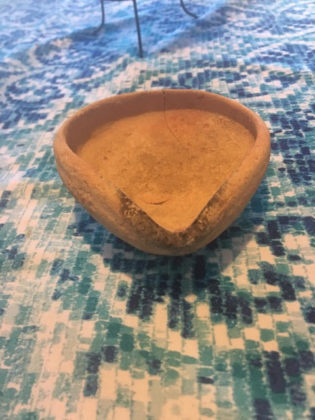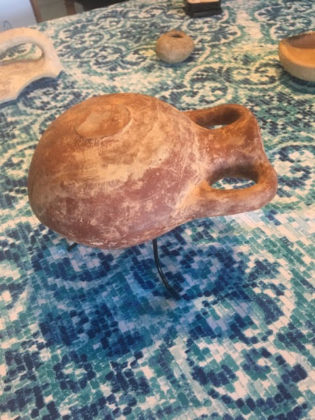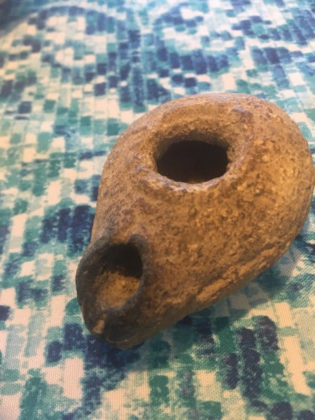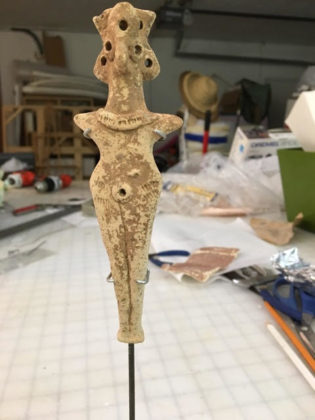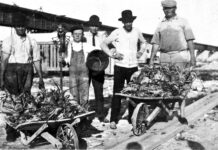Jan. 20 was a significant day for the United States, but it was also an important one for the Keys Jewish Community Center in Tavernier. As Rabbi Richard Agler noted to KJCC members in the online dedication ceremony of the Beiner Collection of antiquities that evening, “It’s a historical day in our country. If you watched the proceedings, you heard dates and times mentioned: 9/11, the Great Depression, the Civil War. American history goes back to, maybe, 1492. The newest object in our antiquities collection predates all those dates by many centuries.”
The collection was just donated to the KJCC by the rabbi and his wife, Mindy Agler, in honor of Judith and Stephen Beiner, and it will be permanently displayed in the center’s lobby in Tavernier. Many of the artifacts in the collection were found in Israel in archaeological digs and date from the Neolithic period (10,000 B.C. to 450 A.D.) through the Islamic period (700 to 900 A.D.). The collection includes an arrowhead, a fertility goddess statue, storage containers for wine and grain, a perfume oil dispenser and oil lamps — all common, everyday objects that show ancient beliefs, customs and practices of daily living.
Apparently, the ancients needed a little faith, bread, wine and perfume to get through their day. And who can’t relate to that? The objects, found far away in a pile of dirt, bring sacred texts like the Torah to life.
“Typically, when we learn in Jewish life, we study texts from various eras in history,” Agler told Keys Weekly. “We might study the patriarchs, the matriarchs, the prophets … just texts, not illustrated. Just black and white words. In the Hanukkah story, there’s the oil lamp, for example, and these (in the Beiner Collection display) are what they look like. When we hear about carrying water from a well, one of those jugs could be what was used. It has a way of adding a dimension to the texts we study.”
Marcia Kreitman is a KJCC member and an artist who helped create the display cases for the objects, along with fellow member Gloria Avner. Kreitman describes being awestruck by holding the artifacts. “It’s amazing to think these were handled by other people and actually used thousands of years ago,” she said. “They’re a connection to other human beings who were putting oil on themselves and drinking wine. It was a wonderful experience and an honor. We were so careful handling things, trying to secure it and make sure it’s not going to slide.”
Elizabeth Hayden is the KJCC’s adult education chairman and kicked off the online dedication ceremony by saying, “This collection is unlike anything else in the Keys. It has traveled a long time and distance to be here.”
The Aglers chose to dedicate the KJCC collection to the Beiners. “They were the ones responsible for my passion, enjoyment and love of archaeology,” said Rabbi Agler. “And they are wonderful human beings. We miss Stephen, who passed on, and we are still blessed to have Judith in our lives.”
Judith Beiner noted in the ceremony that the Israel Antiquities Authority has strict guidelines for buying ancient artifacts. “In Israel, the Antiquities Authority comes in when a construction site starts digging up things (like artifacts). … The authority delegates pieces to museums, but many pieces are allowed to be given to licensed antiquities dealers. Everything is done on a legal basis.”
The IAA is so detailed with documenting artifacts, that if some grains of wheat are found in an ancient jug, the tiny grains are catalogued in addition to the jug.
During the online presentation, Agler showed photos and described each artifact while Judith Beiner added historical facts about them. For example, the pilgrim flask was used to carry wine while traveling (an ancient Yeti tumbler, if you will). “Israelites used the wine to purify water that might have been contaminated,” said Beiner. “But they were not big beer drinkers. The Egyptians were the beer drinkers of the ancient world.”
Another artifact in the collection is a statue called an “Astarte,” which was used as a fertility goddess. “They were found buried under window ledges and door posts [of residences] and were considered omens to help women have fertility,” said Beiner, adding that the modern-day name “Esther” is derived from the word “Astarte.”
For many members, these everyday objects also symbolize a deep pride in their faith and the resilience of their people. “You know, in Jerusalem you can walk on the Cardo,” said Hayden, who explained that she lived in Israel for 10 years and is a citizen. “You have to go down about 15 feet from modern-day level, and you actually can stand on the stones of the Cardo. It was the main north/south road of Aelia Capitolina, the Roman city founded by Hadrian after Titus destroyed Jerusalem.
“I was so happy to stand with my husband, who was a Russian immigrant to Israel, and listen to the guide explain how the Romans planned to wipe us and Jerusalem off the face of the planet,” she continued. “The guide spoke in Hebrew, which was a ‘dead’ language until resurrected in Israel. It gave me goosebumps. We are still here, and the Romans are long gone.”















